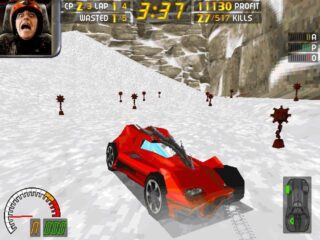Road Rash II is a motorcycle racing combat game developed by Electronic Arts and released in 1992 for the Mega Drive/Genesis. This sequel to the original Road Rash represents the pinnacle of the series on 16-bit hardware, combining high-speed motorcycle racing with brutal street fighting in a formula that predates and influences later combat racers like Twisted Metal and Burnout.
The core gameplay builds upon the foundation established by its predecessor while introducing significant improvements that elevate the experience considerably. Players race through five distinct courses representing different regions of the United States, from California's Pacific Coast Highway to the industrial landscapes of Pennsylvania. Each track offers unique environmental hazards and scenic backdrops that create visual variety while maintaining the series' signature sense of speed and danger.
Combat mechanics receive substantial refinement from the original Road Rash, with expanded weapon options including chains, clubs, and crowbars that can be stolen from opponents or found along roadways. The fighting system emphasizes timing and positioning, as players must balance aggressive attacks with defensive riding to avoid crashes. Successful combat requires understanding each weapon's range and timing, creating a strategic layer that distinguishes Road Rash II from pure racing games like Super Hang-On or OutRun.
The progression system introduces a compelling risk-reward structure where race winnings fund motorcycle upgrades, but arrest or hospitalization costs can devastate your budget. This economic element adds tension to every race, as aggressive tactics might secure victory but increase the likelihood of police encounters or violent crashes. The police presence creates additional strategic considerations, forcing players to balance speed, aggression, and self-preservation in ways that later influenced games like Grand Theft Auto.
Visually, Road Rash II showcases impressive sprite scaling and smooth animation that maximizes the Genesis hardware capabilities. The sense of speed feels authentic and exhilarating, while character animations during combat sequences display personality and humor that enhance the game's rebellious atmosphere. The soundtrack, featuring rock and electronic music, perfectly complements the outlaw biker aesthetic and remains memorable decades later.
Compared to later entries in the series, Road Rash II strikes an ideal balance between accessibility and depth. Road Rash III would add more complexity but lose some immediate appeal, while the 3DO version, known as Road Rash Remake, introduced full-motion video cutscenes and CD-quality audio but altered the core gameplay formula. The PlayStation entries Road Rash: Jailbreak and subsequent 3D iterations moved further from the series' arcade roots.
Road Rash II succeeds because it perfects a unique gameplay concept that no other series has successfully replicated. The combination of racing skill, combat timing, and resource management creates an experience that remains engaging through multiple playthroughs. Road Rash II represents one of the Genesis/Mega Drive's most distinctive and entertaining exclusives, establishing a template for vehicular combat that developers still reference today.














